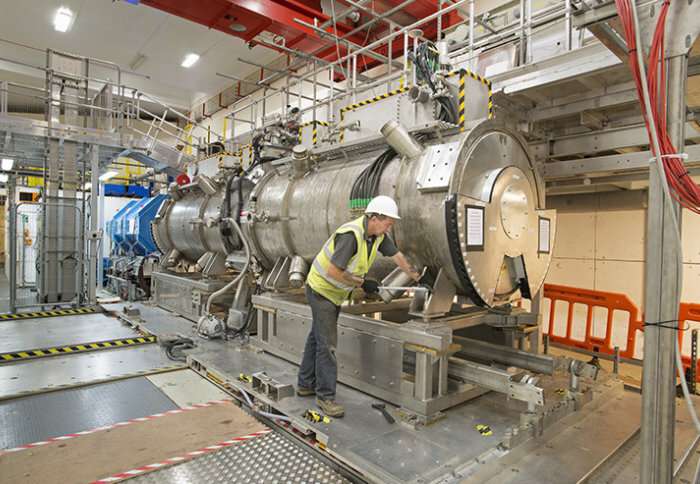World's most powerful particle accelerator one big step closer

Scientists have demonstrated a key technology in making next-generation high-energy particle accelerators possible.
Particle accelerators are used to probe the make-up of matter in colliders like the Large Hadron Collider, and for measuring the chemical structure of drugs, treating cancers and manufacturing silicon microchips.
So far, the particles accelerated have been protons, electrons and ions, in concentrated beams. However, an international team called the Muon Ionization Cooling Experiment (MICE) collaboration, which includes Imperial College London researchers, are trying to create a muon beam.
Muons are particles like electrons, but with much greater mass. This means they could be used to create beams with ten times more energy than the Large Hadron Collider.
Muons can also be used to study the atomic structure of materials, as a catalyst for nuclear fusion and to see through really dense materials that X-rays can't penetrate.
Success of a crucial step
MICE have today announced the success of a crucial step in creating a muon beam—corralling the muons into a small enough volume that collisions are more likely. The results are published today in Nature.
The experiment was carried out using the MICE muon beam-line at the Science and Technology Facilities Council (STFC) ISIS Neutron and Muon Beam facility on the Harwell Campus in the UK.
Professor Ken Long, from the Department of Physics at Imperial, is the spokesperson for the experiment. He said: "The enthusiasm, dedication, and hard work of the international collaboration and the outstanding support of laboratory personnel at STFC and from institutes across the world have made this game-changing breakthrough possible."
Muons are produced by smashing a beam of protons into a target. The muons can then be separated off from the debris created at the target and directed through a series of magnetic lenses. The collected muons form a diffuse cloud, so when it comes to colliding them, the chances of them hitting each other and producing interesting physical phenomena is really low.
To make the cloud less diffuse, a process called beam cooling is used. This involves getting the muons closer together and moving in the same direction. However, so far magnetic lenses could only get the muons closer together, or get them moving in the same direction, but not both at the same time.
Cooling muons
The MICE Collaboration tested a completely new method to tackle this unique challenge, cooling the muons by putting them through specially designed energy-absorbing materials. This was done while the beam was very tightly focused by powerful superconducting magnetic lenses.
After cooling the beam into a denser cloud, the muons can be accelerated by a normal particle accelerator in a precise direction, making it much more likely for the muons to collide. Alternatively, the cold muons can be slowed down so that their decay products can be studied.
Dr. Chris Rogers, based at STFC's ISIS facility and the collaboration's Physics Coordinator, explained: "MICE has demonstrated a completely new way of squeezing a particle beam into a smaller volume. This technique is necessary for making a successful muon collider, which could outperform even the Large Hadron Collider."
"Demonstration of cooling by the Muon Ionization Cooling Experiment" is published in Nature.
More information: undefined undefined. Demonstration of cooling by the Muon Ionization Cooling Experiment, Nature (2020). DOI: 10.1038/s41586-020-1958-9
Journal information: Nature
Provided by Imperial College London



















